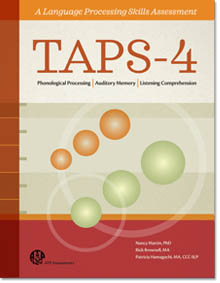
Author(s): Nancy Martin, PhD / Rick Brownell, MS / Patricia Hamaguchi, MA, CCC-SLP
Description
The TAPS-4 provides information about language processing and comprehension skills across three intersecting areas: phonological processing, auditory memory and listening comprehension. These areas underpin the development of effective listening and communication skills, and are critical to the development of higher order language skills, including literacy skills.
The TAPS-4 features new subtests along with revisions to subtests from the TAPS-3, fully updated norms, and an expanded age range. The TAPS-4 subtests were also reorganized into Index and Supplemental subtests, reducing testing burden and increasing flexibility in administration.
The TAPS-4 also features audio administration for the subtests in which proper pronunciation of speech sounds is critical, providing a greater degree of standardization and accuracy during the testing process.
The TAPS-4 has 11 subtests, organized into three indices:
Phonological Processing Index:
Auditory Memory Index:
Listening Comprehension Index:
The TAPS-4 assesses five narrow abilities across three broad skill areas as defined in the Cattell-Horn-Carroll (CHC) theory of cognitive abilities:
Short-Term Memory
Auditory Processing
Comprehension Knowledge
Administration and Scoring
TAPS-4 Index subtests can be administered in one hour or less. Scaled scores are provided for subtests; standard scores are provided for indices and the overall score. Discrepancy scores allow comparison of performance across subtests.
Reliability and Validity information provided in the Product Information box on this page.
The TOPL-2 focuses on the student's ability to interpret a situation accurately.
The MAPA includes eight different subtests in the three skill areas (monaural, temporal, and binaural) that the American Speech-Language-Hearing Association (ASHA) recommends for auditory processing assessment.
Now with expanded norms (ages 2-0 through 70+), this edition is intended for use with - and was normed on - a bilingual population of individuals who speak Spanish and English with varying levels of proficiency.
The TAPS-3 Spanish-Bilingual measures what a person does with what is heard. Nine subtests provide information about a child's auditory abilities in three areas: Basic Auditory Skills, Auditory Memory, and Auditory Cohesion. Normed on Spanish-speaking children.
The Glaspey Dynamic Assessment of Phonology is the first standardized, dynamic assessment of speech production and stimulability.
ROWPVT-4 is a receptive one-word picture vocabulary test that assesses how well persons of all ages can match a word that is heard to objects, actions, or concepts presented in full-color pictures.